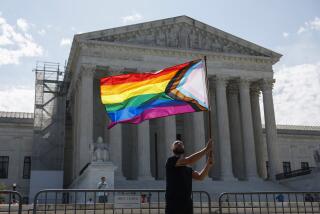The problem with peremptory challenges
- Share via
If lawyers are forbidden to remove prospective jurors based on their race or gender, they shouldn’t be able to do so on the basis of the jurors’ sexual orientation. That’s the rule in California state courts, and this week the U.S. 9th Circuit Court of Appeals was asked to rule that it should apply in federal trials as well.
We agree that all courts should treat sexual orientation in this setting in the same way they do race and gender. But that won’t address the underlying problem, which is that it is easy for lawyers to conceal discriminatory motives for so-called peremptory challenges of prospective jurors.
Peremptory challenges are not to be confused with challenges “for cause,” which are based on factors such as a potential juror’s personal or financial relationship with one of the parties in the case. Historically, peremptory challenges didn’t require an explanation; a lawyer could use one to exclude a juror he merely suspected of being unsympathetic. For example, a defense attorney in an obscenity trial might seek to remove a juror who was active in her church.
In the 1986 case of Batson vs. Kentucky, the Supreme Court held that prosecutors couldn’t use peremptory challenges to exclude prospective jurors based on their race. The court said that once the defendant made a prima facie case that a challenge was racially motivated, the prosecution had to offer a “neutral,” nonracial explanation for the exclusion. Eight years later, the court extended its ruling to cases in which peremptory challenges were used to strike jurors based on their gender.
On Wednesday, the pharmaceutical company SmithKline Beecham asked the 9th Circuit Court to extend the Batson rule to peremptory challenges based on sexual orientation. The company has been involved in a legal dispute with another drug company, Abbott Laboratories, which alienated the gay community by increasing the price of an AIDS medication. At trial, a lawyer for Abbott had used a peremptory challenge to exclude a gay man from the juror pool.
Unfortunately, even if the Batson ruling were extended to cover sexual orientation, it would still be easy for lawyers to disguise their true motives for peremptory challenges. The neutral explanation lawyers can cite for a peremptory challenge can include trivial matters such as a prospective juror’s age, body language or attire. Noting the ease with which Batson could be circumvented, Justice Stephen G. Breyer suggested in 2005 that peremptory challenges be abolished. That’s still a good idea.
More to Read
A cure for the common opinion
Get thought-provoking perspectives with our weekly newsletter.
You may occasionally receive promotional content from the Los Angeles Times.






